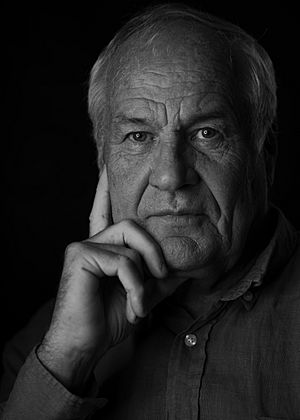Graeme Stephens facts for kids
Quick facts for kids
Graeme Stephens
|
|
|---|---|

Graeme Stephens in 2021
|
|
| Born |
Graeme Leslie Stephens
|
| Alma mater | University of Melbourne (BS, PhD) |
| Known for | CloudSat |
| Awards | Jule G. Charney Award (2005) |
| Scientific career | |
| Fields | Atmospheric sciences |
| Institutions | Caltech Colorado State University University of Reading University of Melbourne |
| Thesis | The transfer of radiation in cloudy atmospheres (1977) |
Graeme Leslie Stephens is a very important scientist who studies Earth's climate. He works at the NASA Jet Propulsion Laboratory in California, where he leads the center for climate sciences. He is also a professor at the University of Reading in the UK, teaching about how we observe Earth from space.
Contents
Education and Early Career
Graeme Stephens went to the University of Melbourne in Australia. He earned his first degree in Physics in 1973. Later, in 1977, he completed his PhD in meteorology. Meteorology is the study of Earth's atmosphere and weather.
Understanding Earth's Climate
Dr. Stephens is a leader in studying our planet. His work helps us understand three main areas of Earth science:
- Atmospheric Radiation: This is about how energy from the sun moves through Earth's atmosphere. It also covers how the Earth sends energy back into space.
- Earth Observations: He uses satellites and other tools to gather information about our planet. This is called remote sensing.
- Clouds and Climate: He studies how clouds affect Earth's energy and climate. Clouds play a big role in how warm or cool our planet is.
Dr. Stephens has helped create new ways to use global observations of Earth. He combines these observations with scientific theories. This helps us learn more about climate change feedback. This means how changes in one part of the climate system can cause more changes.
The CloudSat Mission
One of his biggest achievements is leading the CloudSat satellite mission. He helped design and develop this international project. CloudSat has been orbiting Earth for over ten years. It uses special radar to study clouds and precipitation (like rain and snow). This mission has given scientists amazing new information. It helps us understand how clouds and precipitation affect our climate.
Awards and Recognition
Dr. Stephens has received many important awards for his work.
- In 2005, he received the Jule G. Charney Award. This award recognized his pioneering work in understanding radiation processes and their role in climate.
- He also received the Gold Medal from the International Radiation Commission. This was for his world-leading contributions to the study of radiation.
- The National Aeronautics and Space Administration (NASA) gave him an Exceptional Public Service Medal.
- In 2015, he was chosen as a member of the National Academy of Engineering in the United States.
- He became a Fellow of the Royal Society in 2018. This is a very high honor for scientists in the United Kingdom.
- In 2025, he received the Carl-Gustaf Rossby Research Medal. This is one of the highest awards from the American Meteorological Society.
- Also in 2025, he was appointed a Companion of the Order of Australia. This is a top honor in Australia. He received it for his outstanding service to atmospheric and meteorological science, especially cloud physics and climate change research. He was also recognized for being a great mentor to other scientists.

